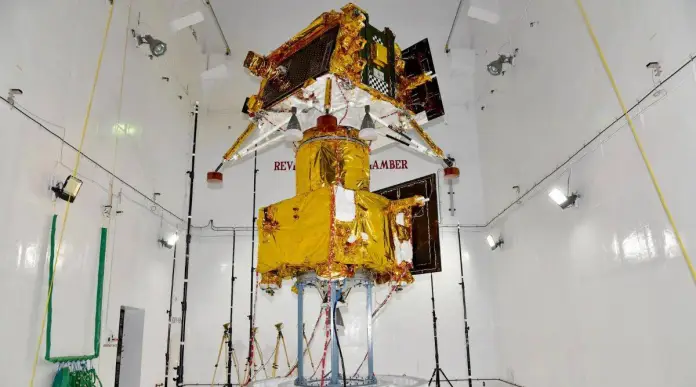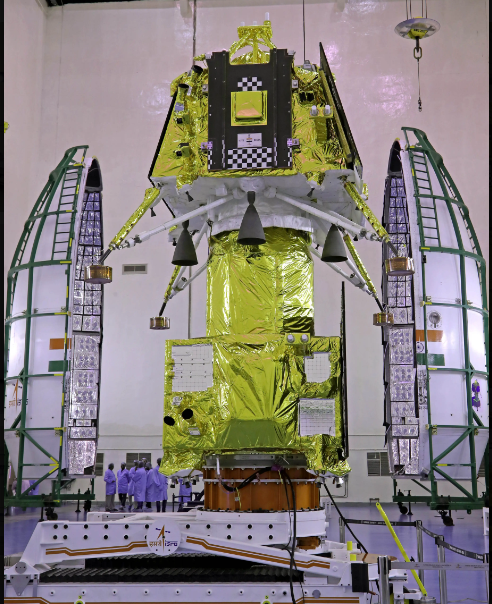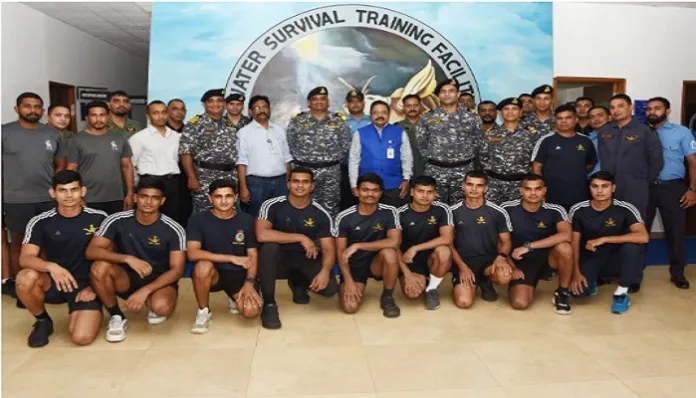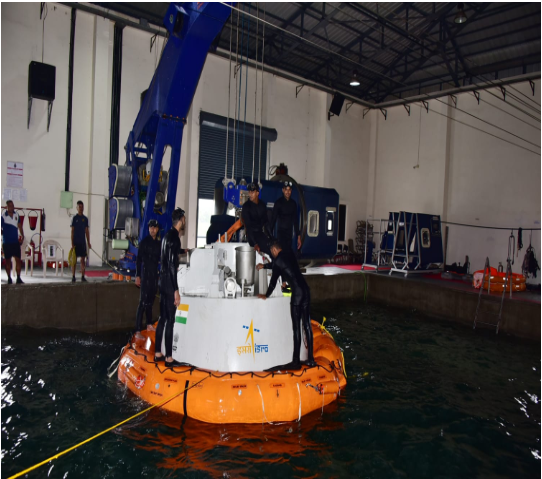avaram 1y ago • 100%
Why all I can think of now, is Terminator T-1000.
avaram 1y ago • 60%
Great, more Gweilo data to collect and process for the Chinese Communist Party.
cross-posted from: https://lemmy.run/post/26776 > *Chandrayaan-3 be launched by Geosynchronous Satellite Launch Vehicle Mark-III from the Satish Dhawan Space Centre in Sriharikota* > >  > > ISRO on Wednesday announced that the launch of Chandrayaan-3 has been scheduled for mid-July. ISRO Chairman S Somnath said the agency is now awaiting its integration with the rocket. > > “The Chandrayaan-3 is already fully built, assembled inside the fairing and we are waiting for integration with the rocket. Currently, the window of opportunity is between 12-19 of July, and we will take the earliest possible date,” Somnath said. > > >VIDEO | Chandrayaan-3 to be launched in July. "The Chandrayaan-3 is already fully built, assembled inside the fairing and we are waiting for integration with the rocket. Currently, the window of opportunity is between 12-19 of July, and we will take the earliest possible date,"… pic.twitter.com/oQhTARAJu9 > > >**-Press Trust of India (@PTI_News) June 28, 2023** > > The ISRO chief said that the window of opportunity to launch is between 12-19 July and the exact date will be announced once all tests are complete. Even so, some reports say the launch date has been fixed 13 July at 2.30 pm. It will be launched by Geosynchronous Satellite Launch Vehicle Mark-III from the Satish Dhawan Space Centre in Sriharikota. > > Chandrayaan-3 is India’s third lunar mission and a follow-on mission to Chandrayaan-2 to demonstrate end-to-end capability in safe landing and roving on the lunar surface. Chandrayaan-3 consists of an indigenous Lander module (LM), a Propulsion module (PM) and a Rover with the objective of developing and demonstrating new technologies required for Interplanetary missions. > >  > > The GSLV-Mk3 will place the integrated module in an Elliptic Parking Orbit (EPO) of around 170 x 36500 km size. > > The propulsion module will carry the LM from launch vehicle injection till final lunar 100 km circular polar orbit and separate the LM from the PM. The propulsion module has a Spectro-polarimetry of Habitable Planet Earth (SHAPE) payload to study the spectral and Polari metric measurements of Earth from the lunar orbit. It has been added as a value addition which will be operated after the separation of the Lander Module. > > The Lander will have the capability to soft land at a specified lunar site and deploy the Rover which will carry out in-situ chemical analysis of the lunar surface during the course of its mobility. The Lander and the Rover have scientific payloads to carry out experiments on the lunar surface. > > The Lander will carry several instruments to study the lunar surface. These include Surface Thermophysical Experiment (ChaSTE) to measure the thermal conductivity and temperature, an instrument for Lunar Seismic Activity (ILSA) for measuring the seismicity around the landing site, and Langmuir Probe (LP) to estimate the plasma density and its variations. A passive Laser Retroreflector Array from NASA is also accommodated for lunar laser ranging studies. > > The rover module will carry Alpha Particle X-ray Spectrometer (APXS) and Laser Induced Breakdown Spectroscope (LIBS) for deriving the elemental composition in the vicinity of the landing site. > > The mission objectives of Chandrayaan-3 are: > > To demonstrate Safe and Soft Landing on Lunar Surface > To demonstrate Rover roving on the moon and > To conduct in-situ scientific experiments. > > The launch was originally scheduled for 2021 but was postponed owing to the Covid-19 pandemic. > > ### Aditya-L1 Mission > > The ISRO chief also gave an update on Aditya-L1 Mission, India’s first mission to study the sun. “Satellites are now getting integrated. Payloads have been developed by various agencies. It has reached the satellite center. Payloads are getting integrated into satellites and it will go through a series of testing,” he said. > > >#WATCH | ISRO chief S Somanath gives an update on Aditya-L1 Mission, India's first mission to study the Sun. > > >He says, "…We are targeting that by August end, Aditya can go." pic.twitter.com/qyOexGlUfw > > >**-ANI (@ANI) June 28, 2023** > > ISRO’s target is to launch Aditya-L1 by the end of August this year. > > Aditya L1 will be the first space-based Indian mission to study the Sun. The spacecraft shall be placed in a halo orbit around the Lagrange point 1 (L1) of the Sun-Earth system, which is about 1.5 million km from the Earth. A satellite placed in the halo orbit around the L1 point has the major advantage of continuously viewing the Sun without any occultation/eclipses. This will provide a greater advantage of observing the solar activities and their effect on space weather in real-time. > > The spacecraft carries seven payloads to observe the photosphere, chromosphere and the outermost layers of the Sun (the corona) using electromagnetic and particle and magnetic field detectors.
cross-posted from: https://lemmy.run/post/26762 > *The training module covered issues like conduct during the mission, actions required during medical exigencies, and technical aspects of aircraft and rescue equipment.* > >  > > *First batch of Crew Module Recovery Team Completes Phase-1 Training (Image Credit - PIB/Ministry of Defence)* > > The first batch of crew module recovery for Mission Gaganyaan has successfully completed Phase-1 training at the Indian Navy’s Water Survival Training Facility (WSTF) in Kochi, reported the Ministry of Defence’s official statement dated 2nd of July. > > As per Ministry’s statement, the team includes Indian Naval divers and the Marine Commandos. They utilised state-of-the-art facilities and underwent recovery training of crew modules in varied sea conditions. > >  > > The team underwent rigorous training for two weeks. The training module covered issues like conduct during the mission, actions required during medical exigencies, and technical aspects of aircraft and rescue equipment. Notably, the standard operating procedures (SOPs) have been jointly formulated by the Indian Navy and ISRO. > > The Ministry said. “The two weeks training capsule covered a brief on the conduct of the mission, actions to be taken during medical exigencies, and familiarisation with different aircraft and their rescue equipment.” > > As per Times of India, this team will participate in the recovery of the unpressurised crew module that will be used in the first abort test mission, which ISRO has planned in August. > > Subsequently, the team was greeted by Dr. Mohan M, Director of the Human Space Flight Centre, ISRO. > > After the completion of the initial phase of training for the first batch, the recovery training program will progress incrementally. It will include unmanned recovery followed by manned recovery training in both harbor and open sea conditions. > > The Indian Navy, in collaboration with other government agencies, is taking the lead in overseeing the recovery operations. > > As per media reports, the crew trained here at Indian Navy’s WSTF will now be involved in the recovery of test launches planned by ISRO in the forthcoming months. > > ### Mission Gaganyaan > > Notably, Mission Gaganyaan is India’s first manned space mission. It was announced by PM Modi during his Independence Day speech in 2018. The mission aims to demonstrate India’s human spaceflight capability. Additionally, with the manned space mission, India wants to join the League of elite nations that are capable of sending humans to space. > > As per the mission statement, a three-member crew will be launched to an orbit of 400 km for a three-day mission. Subsequently, they will be brought back safely to earth, by landing in Indian sea waters. > > The estimated timeframe for the final launch with Indian astronauts onboard is the fourth quarter of 2024.
avaram 1y ago • 100%
I was writing the tutorial in markdown for bash scripting. Somehow the format got messed up. Will fix the format when I can.
In this tutorial, we will learn how to write basic shell scripts using Markdown. Shell scripting allows us to automate tasks and execute commands in a sequential manner. Markdown is a lightweight markup language that provides an easy way to write formatted documentation. ## Table of Contents - [Getting Started](#getting-started) - [Creating a Shell Script](#creating-a-shell-script) - [Running a Shell Script](#running-a-shell-script) - [Variables](#variables) - [User Input](#user-input) - [Conditional Statements](#conditional-statements) - [Loops](#loops) - [Functions](#functions) - [Conclusion](#conclusion) ## Getting Started Before we begin, make sure you have a shell environment available on your machine. Common shell environments include Bash, Zsh, and PowerShell. ## Creating a Shell Script 1. Open a text editor and create a new file. Give it a meaningful name, such as `myscript.sh`. 2. Add the following shebang at the top of the file to specify the shell to be used: ```bash #!/bin/bash ``` Make sure to replace `bash` with the appropriate shell if you're using a different one. 3. Now you can start writing your shell script using Markdown syntax. You can include headers, lists, code blocks, and other formatting elements as needed. 4. Save the file when you're done. Here's an example of a simple shell script written in Markdown: ```markdown # My First Shell Script This is my first shell script written in Markdown. ## Script ```bash #!/bin/bash echo "Hello, World!" ``` ``` ## Running a Shell Script To execute a shell script, you need to make it executable first. Open a terminal and navigate to the directory where your script is located. Then run the following command: ```bash chmod +x myscript.sh ``` Replace `myscript.sh` with the name of your script. To run the script, use the following command: ```bash ./myscript.sh ``` Replace `myscript.sh` with the name of your script. ## Variables Variables in shell scripts are used to store data and manipulate values. Here's an example of defining and using a variable in Markdown: ```markdown # Variables To define a variable, use the following syntax: ```bash variable_name=value ``` For example: ```bash name="John" ``` To use the variable, prefix it with a dollar sign ($): ```bash echo "Hello, $name!" ``` ``` ## User Input Shell scripts can interact with the user by reading input from the keyboard. Here's an example of reading user input and using it in a script: ```markdown # User Input To read user input, use the `read` command followed by the variable name: ```bash read -p "Enter your name: " name ``` The user's input will be stored in the `name` variable. You can then use it in your script: ```bash echo "Hello, $name!" ``` ``` ## Conditional Statements Conditional statements allow you to execute different code blocks based on certain conditions. Here's an example of an if statement in Markdown: ```markdown # Conditional Statements To use conditional statements, you can use the `if` statement followed by the condition and the code block: ```bash if [ condition ]; then # code to execute if the condition is true else # code to execute if the condition is false fi ``` For example: ```bash if [ $age -ge 18 ]; then echo "You are an adult." else echo "You are a minor." fi ``` ``` ## Loops Loops allow you to repeat a block of code multiple times. Here's an example of a for loop in Markdown: ```markdown # Loops To use loops, you can use the `for` loop followed by the variable, the list of values, and the code block: ```bash for variable in list; do # code to execute for each value done ``` For example: ```bash for fruit in apple banana cherry; do echo "I like $fruit" done ``` ``` ## Functions Functions allow you to define reusable blocks of code. Here's an example of defining and using a function in Markdown: ```markdown # Functions To define a function, use the following syntax: ```bash function_name() { # code to execute } ``` For example: ```bash greet() { echo "Hello, $1!" } ``` To call a function, use its name followed by any arguments: ```bash greet "John" ``` ``` ## Conclusion Congratulations! You've learned how to write basic shell scripts using Markdown. Shell scripting is a powerful way to automate tasks and improve your productivity. Explore more advanced features and commands to create more complex scripts. Happy scripting!

cross-posted from: https://lemmy.run/post/25521 > Prompt: Intricately detailed, professional photograph, of(ancient indian temple),magnificent, cinematic view, cinematic lighting, photographed on a Sony a9 II Mirrorless Camera, (highly detailed:1.2), (soft focus), lush forest in background HDR, 8k resolution > > Negative prompt: nsfw,CyberRealistic_Negative,(deformed, distorted, disfigured:1.3), poorly drawn, bad anatomy, wrong anatomy, extra limb, missing limb, floating limbs, (mutated hands and fingers:1.4), disconnected limbs, mutation, mutated, ugly, disgusting, blurry, amputation. tattoo > > Steps: 40, Sampler: DPM++ SDE Karras, CFG scale: 7, Seed: 708755406, Size: 768x512, Model hash: 03363589fe, Model: CyberRealistic_V3.1, Version: v1.3.0

Prompt: Intricately detailed, professional photograph, of(ancient indian temple),magnificent, cinematic view, cinematic lighting, photographed on a Sony a9 II Mirrorless Camera, (highly detailed:1.2), (soft focus), lush forest in background HDR, 8k resolution Negative prompt: nsfw,CyberRealistic_Negative,(deformed, distorted, disfigured:1.3), poorly drawn, bad anatomy, wrong anatomy, extra limb, missing limb, floating limbs, (mutated hands and fingers:1.4), disconnected limbs, mutation, mutated, ugly, disgusting, blurry, amputation. tattoo Steps: 40, Sampler: DPM++ SDE Karras, CFG scale: 7, Seed: 708755406, Size: 768x512, Model hash: 03363589fe, Model: CyberRealistic_V3.1, Version: v1.3.0